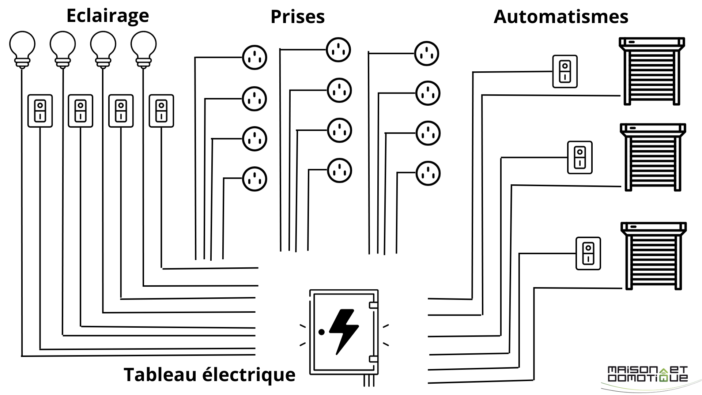When designing a home's electrical system, if you plan to install home automation, one of the crucial decisions to make is the type of electrical diagram to adopt. This is a question I get asked quite often. Two common options are the classic circuit and the so-called “star” circuit. Each of these circuits has advantages and disadvantages, and the choice will depend on the specific needs of the home and its occupants. So, let's explore these two types of electrical diagrams to help you make an informed decision when building or renovating your home.
The Classic Electrical Circuit
The classic circuit is the oldest and simplest approach to electrical diagrams. It's the one installed by default by an electrician. In this type of circuit, all appliances and light fixtures are connected to each other.For example, if you have four electrical outlets one behind the other, and the second one fails, it won't pose a problem for the other three. But if the cable running from the electrical panel to the first outlet has a problem, it affects all the equipment connected to that power line. Likewise, if a switch is faulty, the light it controls will no longer work.
Another disadvantage: if you want to automate the electrical outlets, you'll either have to do it for the entire line in the electrical panel, without being able to distinguish between the different outlets connected to the same line, or you'll have to install smart outlets or insert a micro module behind each one.
A quick diagram to help you understand. Be careful, this is a very simplified diagram; to understand the concept, we're not dealing with a power outage:
Advantages of the classic circuit:

Wiring savings:
- This type of circuit requires fewer cables, which can reduce wiring costs. Ease of installation:
- The traditional circuit is easy to set up because it follows a simple linear diagram that has been used for decades. Disadvantages of the traditional circuit:
Risk of interruption:
- If one of the lines in the circuit experiences a problem, it can interrupt the power supply to all the other devices on that line. Decreased efficiency:
- As more devices are added to the circuit, the overall resistance increases, which can lead to a loss of energy efficiency (there are certain wattages that must not be exceeded on each electrical line). The “wye” electrical circuit
The wye circuit is a more modern and complex approach, often used for home automation installations. In this circuit, each device and light fixture is individually connected to a central point, usually an electrical panel. This means that each device has its own power path from the electrical panel, preventing interruptions in the event of a problem on a specific line. This type of wiring offers many advantages for a modern and scalable home.
Another diagram to illustrate this type of star circuit. This is also very simplified, as this type of circuit quickly becomes very busy. The main idea to remember: each element is directly and individually connected to the electrical panel, which of course requires much more wiring:
Advantages of the star circuit:

Increased reliability:
- In the event of a failure or problem with one line, the others continue to operate normally because they are not connected together. Ease of maintenance:
- Troubleshooting is easier because you can isolate and repair a specific device without affecting the others. Scalability:
- You can easily add new devices to the star circuit without compromising overall performance. Furthermore, it's very easy to change the role of switches, for example. For example, the switch that controls lamp A could very easily control lamp B tomorrow, via a simple modification to the electrical panel. This is impossible with a traditional circuit, as each switch is in series with the lamp it is intended to control. Disadvantages of the star circuit:
Higher initial costs:
- Complex wiring and the need for a larger electrical panel can lead to higher initial costs. This should be put into perspective, however, because radio communications have advanced enormously today, and while it's still necessary to wire outlets and lights, wiring switches can be completely eliminated, as they can be wireless. This not only saves on wiring, but also increases flexibility, as wireless switches can be moved at will (some even place the switches lower for children, and raise them as they grow). Installation complexity:
- Setting up a star circuit requires more careful planning and a more complex installation. Conclusion
Choosing between a conventional circuit and a star circuit will depend on your specific power supply needs, budget and preferences. If simplicity and initial costs are priorities, the classical circuit may be appropriate. However, if reliability, ease of maintenance and scalability are essential, the star circuit is often the best option. In any case, this is what I recommend in the context of a connected home, because we gain a lot in flexibility. If you opt for star wiring, with switch wiring, in this case also remember to bring the neutral with the phase behind each switch. In fact, many home automation devices require it, such as touch screen switches which are becoming more and more popular.
This type of smart switch is beautiful. But requires phase and neutral to be powered!

to get started in home automation“. You will find many answers there on the things to plan for a connected home ;-)Regardless, unless you are a professional, it is recommended to consult a professional electrician to help you make the most appropriate decision based on your particular situation. Whatever the choice, it is essential to respect electrical safety standards to guarantee the safety of your home and its inhabitants.






Please remain courteous: a hello and a thank you cost nothing! We're here to exchange ideas in a constructive way. Trolls will be deleted.